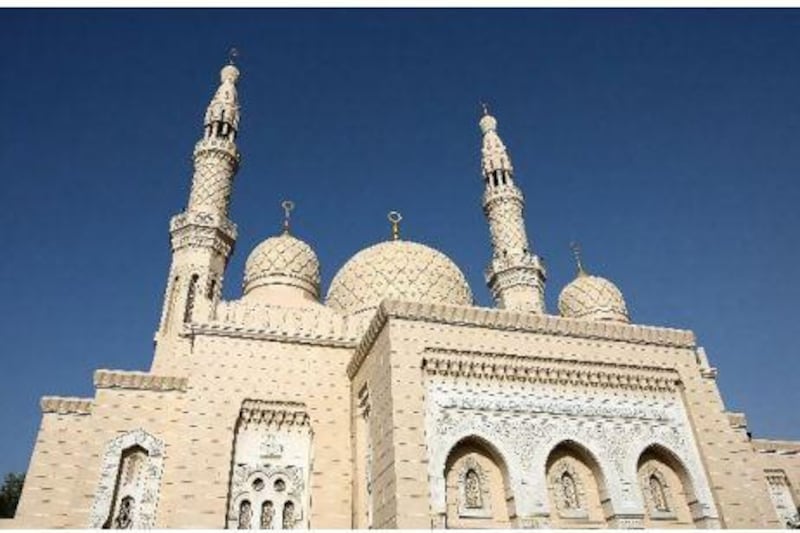DUBAI // In distinct shades of blue and purple, the icons on each side of the Dh500 note represent historic elements that define the spirit of the UAE.
On the front is the majestic head of a falcon, the bird at the heart of Emirati sport and national identity. It is artfully drawn in grey-brown, purple and blue.
On the back is the Jumeirah Mosque, one of the largest in Dubai. It was one of the first mosques in the country to open to non-Muslims in a gesture of tolerance and religious understanding.
The mosque is one of the most photographed in Dubai, and was built under the order of the late Ruler of Dubai, Sheikh Rashid, as a gift to the public.
Built in the Islamic Fatimid style (909-1171AD) - marked by keel-shaped arches and domes with intricately carved arabesque and floral designs - it took four years to build, officially opening in November 1979.
Similar in colour scheme to the Dh500 note, the mosque has purple and blue decorations on its inside arches, along with yellow and green tinted windows.
Boasting two minarets with one central dome and four on each corner, the beige mosque is lit by kaleidoscopically coloured, traditional Arabic lanterns hanging across its periphery. It can accommodate 1,200 worshippers.
"Inside the mosque, we are all equal. A manager stands next to a tea boy," said Latifa Flook, 42, from the UK, who has been guiding tours at the mosque since 1998.
The tours are part of The Sheikh Mohammed Centre for Cultural Understanding's programme Open Doors, Open Minds.
"The first thing visitors say when they come inside the mosque, is 'Wow!'," said Mrs Flook, a convert from Christianity to Islam who has lived in Dubai for more than 20 years.
She takes visitors through the rituals and rules inside the mosque, including wudu or ablution, so that when they decide to go to another mosque, they know what is expected and proper.
Tours take place on Sundays, Tuesdays, Thursdays and Saturdays. No appointment is needed. Interested individuals can just show up at 10am at the mosque, on Jumeirah Beach Road, and everything is provided for them, including proper attire.
"It is about bridging differences and leaving with an understanding of what is Islam and what happens inside a mosque," said Mrs Flook.
The Dh500 note was issued in 1982 by the Central Bank. The first UAE dirham went into circulation on May 19, 1973.
For some, the Dh500 note represents power because of its value.
"When you look at a 500 dirham bill you feel some sort of power," said Souad Jamal Al Serkal, 25, an Emirati writer who works at the Sheikh Mohammed Centre for Cultural Understanding and is the external affairs officer at Zayed University in Abu Dhabi. "It shows you belong to a sector of people who can afford to have a 500-dirham note and some change to go with it."
Also, she joked: "A 500 dirham bill also means you don't have change."
She said that while the falcon represents wealth and power, the mosque has far more sentimental value for her.
"It reminds me of my grandparents, God rest their souls," she said. "My mother's parents are from Lebanon, and they used to come visit us all the time, and back then this mosque was their favourite. Every time I pass by it, I remember them and smile."
Others prefer the falcon, seen by many as the most patriotic symbol of the UAE.
Falconry was recognised by the United Nations Educational, Scientific and Cultural Organization (Unesco) in 2010 as an example of intangible cultural heritage, after four years of intensive campaigning by the UAE.
"In the pre-oil era, the falcon helped us survive through its uncanny hunting skills in the desert," said Ali Al Khateri, a member of the desert tribe of Khawater.
Owning 10 falcons, Mr Al Khateri is often seen with one in public and even inside his car.
"They are my children, I spoil them and make sure they wear the best hoods and regularly get their exercise," said the 35-year-old Emirati.
"The falcon is beautiful and sharp, and it is properly represented on each of the dirhams in the corner, and in the centre of the 500 dirham bill."






